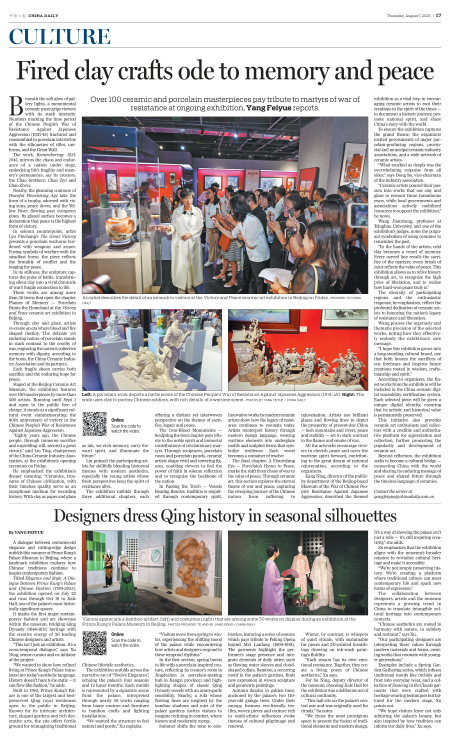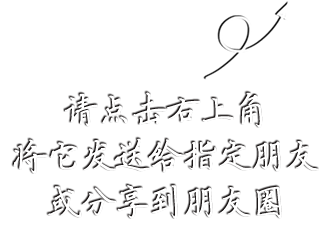
Visitors appreciate a bamboo artifact (left) and costumes (right) that are among some 50 works on display during an exhibition at the Prince Kung's Palace Museum in Beijing.

Online Scan the code to watch the video.
A dialogue between centuries-old elegance and cutting-edge design unfolds this summer at Prince Kung's Palace Museum in Beijing, where a landmark exhibition explores how Chinese traditions continue to inspire contemporary fashion.
Titled Elegance and Style: A Dialogue Between Prince Kung's Palace and Chinese Fashion (1780-2025), the exhibition opened on July 22 and runs through Oct 19 in Jiale Hall, one of the palace's most historically significant spaces.
It marks the first major contemporary fashion and art showcase within the museum, bridging Qing Dynasty (1644-1911) heritage with the creative energy of 26 leading Chinese designers and artists.
"This isn't just an exhibition. It's a cross-temporal dialogue," says Xu Ning, senior curator and co-initiator of the project.
"We wanted to show how refined living at Prince Kung's Palace translates into today's aesthetic language. History doesn't have to be static — it can flow like fashion," he adds.
Built in 1780, Prince Kung's Palace is one of the largest and best-preserved Qing royal residences open to the public in Beijing. Known for its intricate architecture, elegant gardens and rich decorative arts, the site offers fertile ground for reimagining traditional Chinese lifestyle aesthetics.
The exhibition unfolds across the narrative arc of "Twelve Elegances", echoing the palace's four seasons and 12 lunar months. Each month is represented by a signature scene from the palace, interpreted through nearly 50 works ranging from haute couture and furniture to bamboo crafts and lighting installations.
"We wanted the structure to feel natural and poetic," Xu explains.
"Visitors move from spring to winter, experiencing the shifting mood of the palace while encountering how artists and designers respond to these temporal rhythms."
In the first section, spring bursts to life with a porcelain-inspired couture, reflecting its creator's roots in Jingdezhen (a porcelain-making hub in Jiangxi province) and highlighting shapes of classic Qing Dynasty vessels with an avant-garde sensibility. Nearby, a sofa whose flowing lines are inspired by the bamboo shadows and mist of the palace gardens invites visitors to imagine reclining in comfort, where history and modernity merge.
Summer shifts the tone to celebration, featuring a series of couture which pays tribute to Peking Opera legend Mei Lanfang (1894-1961).The garments highlight the performer's stage presence and integrate elements of daily attire, such as flowing water sleeves and cloud-shaped collars. Bamboo, a recurring motif in the palace's gardens, finds new expression in woven sculpture and geometric paintings.
Autumn dazzles in golden hues, anchored by the palace's two 110-year-old ginkgo trees. Under their canopy, lustrous eco-friendly textiles, woven pieces and couture rich in multi-ethnic influences evoke themes of cultural pilgrimage and renewal.
Winter, by contrast, is whispers of quiet rituals, with sustainable fur pieces and 3D-printed furnishings drawing on ink-wash painting's fluidity.
"Each season has its own emotional resonance. Together, they create a living poem of Chinese aesthetics," Xu says.
For Su Ning, deputy director of the museum, choosing Jiale Hall for the exhibition was a deliberate act of cultural continuity.
"This hall sits on the palace's central axis and was originally used for rituals," Su notes.
"We chose the most prestigious space to present the fusion of traditional elements and modern design. It's a way of showing the palace isn't just a relic — it's still inspiring creativity," she adds.
Su emphasizes that the exhibition aligns with the museum's broader mission to revitalize cultural heritage and make it accessible.
"We're not simply preserving history. We're creating a platform where traditional culture can meet contemporary life and spark new forms of expression."
The collaboration between designers, artists and the museum represents a growing trend in China to translate intangible cultural heritage into contemporary contexts.
"Chinese aesthetics are rooted in harmony with nature, in subtlety and restraint," says Xu.
"Our participating designers are interpreting these values through modern materials and forms, creating works that resonate with younger generations."
Examples include a Spring Garden Gathering series, which infuses traditional motifs like orchids and frost into everyday wear, and a collection of Dancing in the Clouds garments that were crafted with heritage weaving techniques but tailored for the modern stage, Xu points out.
"We hope visitors leave not only admiring the palace's beauty, but also inspired by how tradition can inform our daily lives," Xu says.

